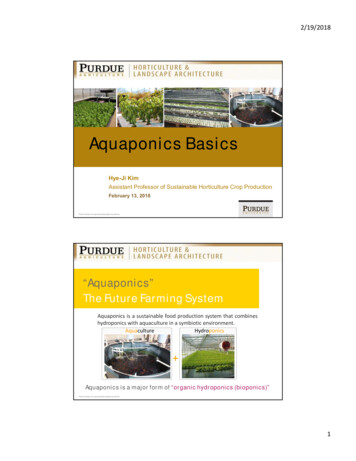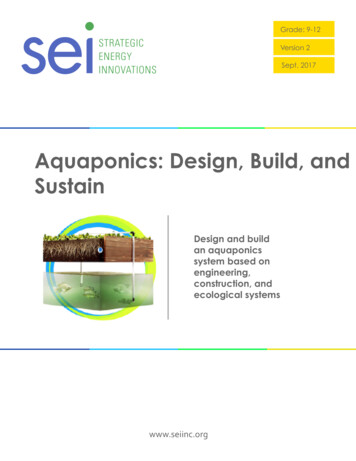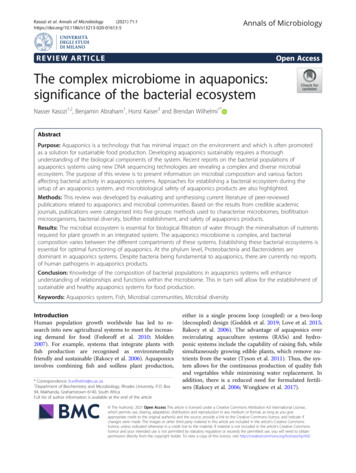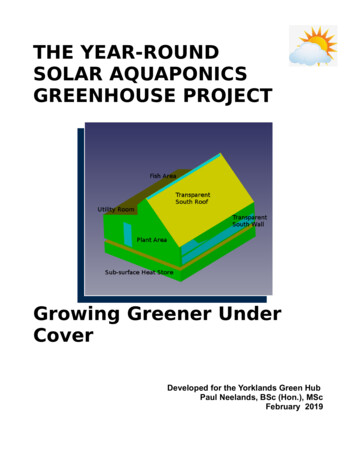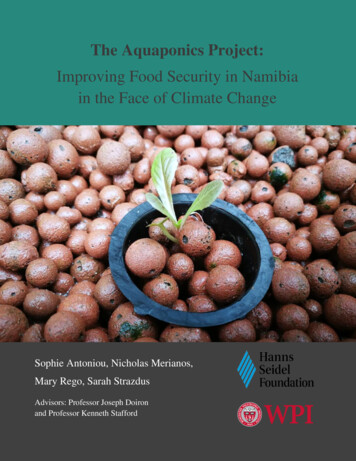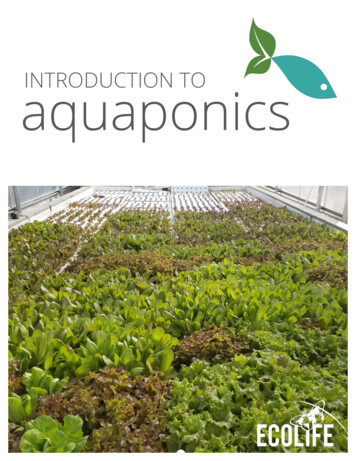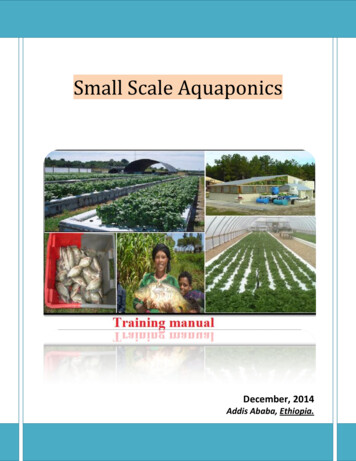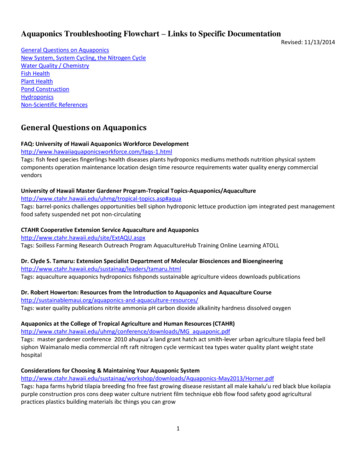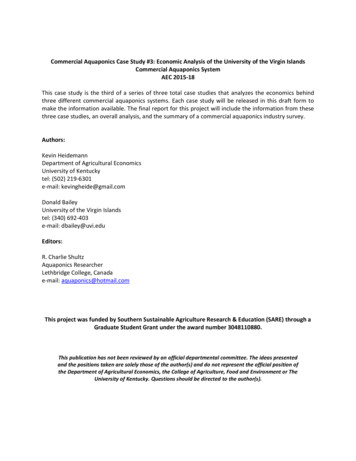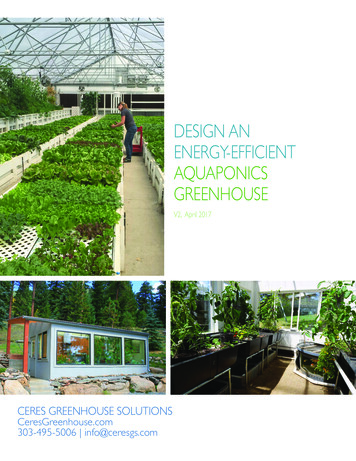
Transcription
DESIGN ANENERGY-EFFICIENTAQUAPONICSGREENHOUSEV2, April 2017CERES GREENHOUSE SOLUTIONSCeresGreenhouse.com303-495-5006 info@ceresgs.com
TABLE OF CONTENTS:0406091012131416About this GuideCreate An Efficient, Durable GreenhouseCreate A Floor PlanPlan For Grow BedsPlan For Fish TanksDecide On FlooringPlan For ElectricalPlanting Tips303-495-5006 info@ceresgs.comCeresGreenhouse.com
ABOUT CERESCeres Greenhouse Solutions started with the idea of applying energy-efficient building designto greenhouses (notoriously inefficient structures). As a result, we build ‘greener greenhouses’-- those that save energy, water and money; operate independently; and grow abundantlyyear-round. As energy-efficient, durable and customizable structures, we’ve found thesegreenhouses to be a natural fit with aquaponic growing methods. Over many years, we havecontinued to refine efficient greenhouse design for aquaponic growers, leading to this e-book.ABOUT THIS GUIDEThe purpose of this e-book is to provide a framework for growers todesign a durable, cost-effective and abundant aquaponic greenhouse.The principles can be applied to greenhouses in any climate andsize -- whether growing as a hobby or commercially. Importantly,however, these recommendations should be tailored for your specificclimate and growing goals. This guide is intended to provide a generalframework for planning an aquaponics greenhouse, which you shouldthen customize for your specific situation.If you need further advice on your aquaponics greenhouse, we offerhourly consulting, custom designs and engineering to assist you.Finally, we would love to hear your feedback about this guide. What washelpful and what questions do you still have? Please help us improveour resources -- share your thoughts with us at info@ceresgs.comPhoto top left and bottom left from Flourish Farms in Denver, CO. Bottom leftFlourish Farms with ZipGrow Towers.4
DON’T DO THISWhy build an energy-efficient greenhouse? uctures to operate year-round in most climates.This is because conventional greenhouses arenormally constructed out of thin sheets of glass orplastic. Collectively called “glazing”, these materialsare extremely poor insulators. They let tons of heat induring the day -- causing the greenhouse to overheat-- and quickly lose this heat at night -- causingthe greenhouse to over-cool or freeze. As a result,a typical greenhouse normally experiences hugetemperatures swings if uncontrolled. For example,the structure can easily go from freezing (32 F) toover 100 F within 24 hours on a sunny winter day.This intense temperature fluctuation will stress or killplants. To accommodate, most growers must heatand cool the greenhouse, resulting in high energycosts and a dependence on fossil-fuels.We should note that some growers have otherstrategies for growing year-round sustainably. EliotColeman, author of The Winter Harvest Handbook,is well-known for growing cold-tolerant crops likespinach through the winter without heating, on hisfarm in Maine. He does this by choosing hardy varietiesand using additional layers of crop protection, like rowcovers, in the greenhouse. That is challenging in anaquaponics greenhouse, however, where both the fishand plants must be stable temperatures. In fact, fishtank heating is the top challenge for most aquaponicgrowers. Fish maintain their body temperature viawater, which should not fluctuate by more than a fewdegrees. An energy-efficient greenhouse makes it fareasier to control the water temperature, and growhealthy fish.Above: A plastic kit greenhouse collapsed ina wind storm just a few weeks after it wasput up. Standard greenhouses are usually notdesigned for the high snow or wind loads ofmany climatesFinally, a energy-efficient greenhouse is usually moredurable due to better materials. Most traditionalgreenhouses are not rated for high snow and windloads, putting your investment at risk.For those reasons, a durable and energy-efficientgreenhouse tends to be far better equipped foraquaponic gardening. Energy-efficient greenhousesare able to grow more variety -- plants like bananas,avocados, figs, etc. -- using less energy and resources.5
1Create an Efficient, Durable GreenhouseQuestions to ask: What do I want to grow and when? What minimumtemperatures do I need?There are several ways to create an energy-efficient, year-round greenhouse. Most methodscenter on passive solar greenhouse design, a design philosophy which advises takingadvantage of free solar energy, using some straightforward building principles outlinedbelow.Passive Solar Greenhouse DesignOrient the greenhouse towards the Sun. In the Northern hemisphere, the majority ofthe glazing should face South to maximize exposure to light and solar energy.Insulate areas that don’t collect a lotof light. In most North American climates,most light comes from the South. TheNorth wall of a greenhouse plays a minorrole in light collection, and thus is betterleft insulated to reduce heat loss. Werecommend insulating the North wall of thegreenhouse similarly to the walls in yourhome. We typically use between R-10 toR-20 insulation. Some areas on the Eastand West sides of the greenhouse canbe insulated as well, depending on yourclimate and light availability.A solar greenhouse relies on natural elementsfor year-round heating and cooling. Designscan be as simple / economical or as creative asyou would like., and can be applied to any sizestructure. See more examples of residential andcommercial solar greenhouses on our Photospage at ceresgs.com. Photos at right from CeresGreenhouse Solutions.6
Insulate underground. Insulating aroundthe perimeter of the greenhouse allowsthe soil underground to stay warmer. Thiscreates a “thermal bubble” under thegreenhouse that acts as thermal massand helps stabilize temperature swings.Maximize light and heat in the winter. Togrow year-round without dependence onlights or heaters, it is crucial to maximizesunlight in the greenhouse during thecolder months. This is done by using properglazing materials and angling the glazingfor winter light collection in general,using the glazing area strategically.Reduce light and heat in the summer.Growing during the warmer monthscan mean challenges with overheating.Strategic shading, glazing placement andangles reduce unnecessary light and heatin the summer.Use Thermal Mass (or other thermalstorage techniques). Thermal mass refersto materials that store the excess heatin the greenhouse during the day, andslowly radiate it at night or when needed.This evens out temperature swings andcreates a more controlled environment.Almost all solar greenhouses have somemechanism to store heat, broadly referredto as thermal storage. Methods for storingthe passive solar heat vary widely andare discussed in-depth in The Year-RoundSolar Greenhouse.Ensure sufficient ventilation Naturalventilation ensures a healthy growingenvironment and controls overheating.Use materials intended for humidenvironments. Humidity is a majorconsideration when selecting buildingmaterials.Further ReadingFor more on the principles above, and buildingyour own year-round greenhouse with passive solardesign, we recommend our book, The Year-RoundSolar Greenhouse, available at ceresgs.com.7
Additional Tips for WarmClimate GreenhousesShade part of your roofFor most of the year, sunlight coming in throughthe top section of the greenhouse roof will notdirectly hit the growing beds in a solar greenhouse.This is due to the angle of the sun (called thesolar elevation), which varies by latitude. If thisarea does not directly illuminate plants, it is bestcovered with shade cloth or an insulating material,in order to reduce unnecessary heat gain in warmclimates. A shaded area can be particularly usefulif you have fish tanks and equipment on the Northwall, which are best left in the shade.Shade tanks & leave them openFor those in hot and dry climates, you can take advantage of evaporative cooling from fishtanks. As air moves across the surface of the water, it will evaporate and absorb energy inthe process. This only works well in dry climates. You must be cautious of over-humidifyingthe greenhouse, so proper ventilation is key. Evaporative coolers are another tactic to aircondition a greenhouse in a hot and dry climate.Additional Tips forCold Climate GreenhousesInsulate part of your roofAs mentioned above, a section of the roof does not contribute greatly to illuminating growbeds. Thus, for cold-climate greenhouses we recommend reducing heat loss through yourroof by installing insulation at the top of the roof. The length of insulation will depend onyour latitude (solar elevation angles) and floor plan.Insulate fish tanks and plumbingYou can reduce the cooling effect of evaporativecooling - as water evaporates from the surface ofthe tanks - by covering tanks in the winter. JeremiahRobinson, who runs Frosty Fish Aquaponics inMadison WI, is a big proponent of this. He convertsold freezers into fish tanks to create sealed, insulatedtanks with air-tight lids. This requires using anaeration device to oxygenate the water, but savesa large amount of energy. He also recommendsinsulating any area where heated water will circulate,such as plumbing. Plumbing insulation is a simple,low-cost tactic to reduce water heating costs. Moreinformation at frostyfish.com.8Photo, top - effect of shading. Photo below - pipe insulationfrom Frosty Fish Aquaponic Systems.
2Create a General Floor PlanQuestions to ask: What do I want to grow? How much space do I need?Identifying the basic size and layout of youraquaponic system - and its arrangement inthe greenhouse - is a critical step to yourgreenhouse design. You should know yourgoals and available resources. Budget is anobvious factor, so you may want to lay out ageneral floor plan, then get cost estimates,and revise if needed.We recommend starting out planning spacefor your grow beds, and then using your bedarea to determine the volume of fish tanks.The ratio of fish tank volume to bed spacevaries by aquaponic system. You shoulddo further research for your specific setup, however some basic general ratios canprovide a starting point. For example, in herbook Aquaponic Gardening, Sylvia Bernsteinrecommends residential growers begin with amedia bed system, and use a starting ratio of1:1 of grow bed volume to fish tank volume(assuming a stocking ratio of 1 lb. maturefish per 5-10 gallons of water). That meansthat fish tanks will a significant portion of thefootprint of the greenhouse.You may also want to consider space for:Water heatersHeaters are usually electric, propane, ornatural gas. Using renewable resources likesolar hot water for is also possible (see casestudy, page 21, for an example).Space HeatersThere are a huge range of options for heatingyour greenhouse. The heat requirement(and thus equipment needed) depend onyour climate, growing goals (minimumtemperature requirements) and structuretype. We explain in-depth many options forsustainable / renewable heating in The YearRound Solar Greenhouse. Many growersintegrate electric or propane heaters tomaintain suitable air temperatures.Water StorageMany growers find it helpful to store dechlorinated water inside the greenhousein order to top off fish tanks in the winter.Storing water outside while it de-chlorinatesis not an option in areas with freezing winters.Adding additional water storage inside thegreenhouse has the bonus of adding morethermal mass and passive climate control.Potting/Work TableHang-out AreaGreenhouses can be for more than justgrowing. Consider integrating spaces forsitting, teaching or relaxing.Photo from Ceres Greenhouse Solutions9
3Plan for Grow BedsQuestions to ask: What type of system will I be using?How much grow bed area do I need?This e-book does not cover the range of aquaponicgrowing systems - whether media beds, rafts, wickingbeds, or vertical towers. Our goal is to how show tointegrate an aquaponic system thoughtfully into yourgreenhouse design.As a starting point, we recommend locating grow bedsin the highest light areas of the greenhouse. If using apassive solar greenhouse design, and in the Northernhemisphere, this will be in the center and southernareas of the greenhouse. Accordingly, fish tanks andequipment should be located along the North wall,to reduce unnecessary sun exposure on tanks andequipment.Tip: Insulate Below BedsFor residential growers, we recommenddetermining your bed height before you buildyour greenhouse. Then, build an insulated kneewall below the height of your beds. Glazingbelow the beds does nothing for growth. It onlyexposes the beds and root systems to cold airat night and intense heat gain during the day.You want to keep your beds and root systemsat a stable temperature. The best way to dothis is to insulate around them. If building yourown greenhouse or buying a custom design, werecommend identifying the height of your beds(usually hip height or 2-3’ above ground). Then,design the greenhouse with a framed insulatedknee wall up to the sill of the beds (shown inphoto right). You can install rigid foam boardinsulation between studs or framing membersof the wall.10Photo top - Flourish Farms. Photo bottom - media bedsystem with insulated knee wall, Ceres Greenhouse.
Growing UpA 10’ x 10’ greenhouse has 100 sq. ft. of floor space, but1,000 cubic feet of volume. That fact illuminates whymany growers can take advantage of vertical growing togreatly increase their yields. In greenhouses with passivesolar design, we normally recommend planting verticallyalong the North wall -- so as not to block light from otherplants. There are several options for integrating verticalgrowing methods, whether home-made or purchasedsystems. They include:Growing towers like Living Towers or ZipGrow plantersfrom Bright Agrotech are good options if you are lookingfor a kit system.Wall planters or other small-scale systems likeWooly Pocket, gSky planters or Live Wall systems canbe sold as individual units for residential greenhouses.These are usually pricey, but are easy to install.There is a huge array of DIY systems that residentialgrowers may want to integrate. These can made outof rain gutters, recycled plastic bottles, or your owncreation. See Ceres’ blog for more ideas and instructionson building your own planters, like the recycled sodabottle planters at right.Photos top - Flourish Farms and ZipGrow towers. Photos leftmiddle, bottom - soda bottle planters in a Ceres greenhouse11
4Plan for Fish TanksQuestions to ask: Should I have tanks above ground or buried?As we noted earlier, try to keep fish tanks out of direct light. Direct light promotes algalgrowth and is stressful for fish. It is also generally much easier to heat tanks than to coolthem. In addition, you can choose between burying your fish tanks and / or sump tankspartially underground, or having the tanks above ground. Some considerations.Underground tanks have the advantage that youcan build a platform over the tank and use it forgrowing space, or a work area. The soil also actsas natural insulation and thermal mass. But, bemindful of your soil temperatures. In most climatesthe soil will probably be colder than your ideal watertemperature, and will suck heat away from the fishtank. To accommodate, we recommend insulatingthe perimeter of the greenhouse underground;actively heating the soil with a Ground to Air HeatTransfer (GAHTTM) system; or insulating the tanksthemselves. The disadvantage of underground tanksis that they are harder to empty and clean. You alsomust plan their location in early on, and be sure of it.Underground tanks are hard to adjust.Above-ground tanks make it easier to drain andclean the tanks. They can also make it easier tomonitor the fish. If using the greenhouse in a teachingor demonstration capacity, fish are a big attractionand you may want to build fiberglass view windowsinto the tanks.Photo top right: Underground tanks at Growing Power, Milwaukee,Wisconsin. Photo bottom right: Fish viewing at Bigelow BrookTip: Insulate your tanks12Insulate around your fish tanks to reduce heat loss and the waterheat requirement. Bubble wrap or flexible insulation allows for easyinstallation. Larger aquaponic operations can even have a separatedinsulated room (i.e. a head house or equipment room) on the northside of the greenhouse for tanks.
5Decide on FlooringQuestions to ask: How can you create a stable and level floor?In addition to fish tanks, sump tanks can also be buried underground. In many cases sumptanks are logically located beneath the grow beds, so that water drains directly into themvia gravity. (This is the typical set-up in the ‘Constant Height, One-Pump,’ or CHOP, systemshown below).If either sump or fish tanks will be buried, keep this in mind when choosing a flooringmaterial. If using a concrete, for example, you must leave space open for the tank whenpouring the pad.Flooring OptionsPhoto courtesy of The Aquaponic SourceConcrete is the most expensive option, but also probably the nicest long-term. It createsa permanent, level surface for all your systems. It is easy surface to clean and maintains aclean environment. The disadvantage with concrete floors is that if you want to bury yourfish tanks, sump tanks or plumbing systems, you will not be able to easily alter your layoutin the future, so you forgo some flexibility. A concrete pad should have a surface drain.Tip: Plan plumbing earlyMany growers install the flooring and then the aquaponic systems.Going that route can leave you with plumbing that sits on top ofthe floor and becomes a tripping hazard. We recommend buryingplumbing lines before installing the flooring. You can install aconcrete plumbing trench for pipes. Alternatively, you raise yourwalkways to a level walking surface above the plumbing.13
Gravel, Pavers or Stone are all good options for residential orsmall commercial greenhouses. They create a level surface anddrain well if you have installed floor drains (recommended). Theyalso allow for some flexibility if changing your design and floorplan.you can adjust or access buried plumbing if necessary. Thedownsides are that gravel can’t be hosed down and does not allowfor wheeling equipment or tanks around.Dirt is not recommended. You are more prone to pests. Moreover,dirt under the weight of large sump tanks or water tanks willcompact over time. If going this route, make sure to compact thefloor before installing systems so that tanks and beds will stay level.6Plan for ElectricalQuestions to ask: What equipment will run and how often? How will I connect thegreenhouse to electricity?Every aquaponics system, and everygreenhouse is different and thus there ishuge variation on heating and electricalrequirements. To help you (and / or yourelectrician) plan for the electric system,you’ll need to know the total power draw,or electric load of all the equipment in yourgreenhouse. The major energy users toconsider are: 14Water pumpsWater heaterAeration pumpsElectric space heaters, if neededGrow lights, if neededTo determine the total power draw you willneed to identify the energy usage of eachdevice. This should be listed in the productspecs, usually in Watts. You will also needto estimate how often the device will run.Combined, these metrics determine the totalenergy usage of the device. You will need toadd this for each device in your greenhouse.Once you know your total energy draw, youcan talk to an electrician about your electricalplan and wiring the greenhouse (or proceedwith it yourself if you have experience).You need to make sure you have areliable power supply, and some growers(particularly commercial operations) shouldconsider back-up power available in case ofan outage. We recommend Chapter 17 ofThe Year-Round Solar Greenhouse for moreon the process of wiring your greenhouse.Finally, all electric outlets should be abovewater levels, and should be protected witha Ground Fault Current Interrupter (GFCI)and waterproof covers.
Going Off-GridWhen considering how to power your greenhouse, you have the same options as withany new electrical system (residential or commercial). Most growers connect to the grid.There is also the option of integrating solar panels. If considering adding solar panels(solar PV), your options are the same for homes: you can create a grid-tied system;a grid-tied system with battery back-up; or a stand-alone system (often called an offgrid system). If trying to go off-grid, we advise using an efficient or renewable sourceof heating, such as solar hot water, rocket mass heaters, or climate batteries / GAHTTMsystems to reduce the total power demand ofthe greenhouse. Efficient systems will greatlylower the electric load of the greenhouse andmake an off-grid solar PV system economicallyfeasible. We delve into the options for solarPV much further in our book, The Year-RoundSolar Greenhouse, and in articles on our blogat ceresgs.com.Photo, right - Greenhouse at The Golden Hoof FarmWhere to Start?Since many elements of planning agreenhouse are interconnected, sometimesit can be hard to know where to begin. Ifstarting from scratch, here is a good gameplan:1. First you have to know what you wantto get out of the greenhouse.generally,what do you want to grow and how much.How big does it need to be to producewhat you would like?2. This will determine your plant basic bedlayout, which will in turn determine howmany fish tanks you need. The result isyour basic floor plan.3. Then go to the structure. How do I createan environment that will make theseplants happy? Tomatoes are differentthan kale. Cold hardy micro-greens havedifferent temperature requirements thantropical fruit trees. If going for a largevariety, aim to please the plants thatneed the warmest temperatures. Youshould have a general idea of how yourgreenhouse is going to perform, and howdifficult or easy it will be to control. Toget a better idea talk to other growersin your area, or talk to a Ceres projectmanager about an energy analysis of thestructure.4. Once you have a rough idea of how yourgreenhouse will perform, flesh out thecomponents of your aquaponics system.If you anticipate your greenhouse willtrack air temps and you live in Montana,you will need a sizable water heater.If you are planning a well-insulatedgreenhouse that utilizes thermal mass,are in a moderate climate, you may onlyplan a small back-up water heater.5. From here, you can finish out the system:electric requirements; water hook-ups;and additional accessories like lights andexhaust fans.15
8Planting TipsWhen growing in an energy-efficient greenhouse, be mindful of plants shading each other.In solar greenhouses, tall plants on the South side of the greenhouse can shade those inthe back. To avoid this, we recommend placing taller and vining crops like tomatoes alongthe North wall.Solar greenhouses also experience micro-climates: zones of the space which have differentclimate conditions. One important micro-climate to be aware of is the area directly next thewindows / glazed walls of the greenhouse. These zones generally experience much greatertemperature swings, particularly the cold temperatures over night. Beds closest to theglazing / windows are a good area for hardy crops, while sensitive crops can be planted inthe interior or along an insulated North wall.Like many topics, growing in an aquaponic greenhouse warrants much more discussionthan we can provide here. Books like Aquaponic Gardening, and The Greenhouse GardenersCompanionarehelpfulresources for refining yourgrowing strategies.Photo courtesy of TheAquaponic Source.Need help?Designing an aquaponics greenhouse can be a big endeavor. We’re here to help you get itright, the first time. Get in touch with us for a free consultation or expert advice - info@ceresgs.com. Folks at The Aquaponic Source can help you create an ecologically balanceddesign -- info@theaquaponicsource.com.16
9Designs and Floor PlansExamples of existing aquaponic greenhouses can help identify the best greenhouse design/ layout for you, or illuminate the possibilities. Below are several year-round aquaponicsgreenhouses ranging from residential to small-scale commercial.Residential Greenhouse with Turn-Key System240 sq. ft. AquaponicsGreenhouseThis 12’ x 20’ greenhouse was constructed from wood framing, triplewall polycarbonate and glass viewwindows, following engineered plansfrom Ceres Greenhouse Solutions.The kit aquaponics system is theAquaBundance system from TheAquaponic Source.17
Aquaponics Kit GreenhouseThis 924 sq. ft. greenhouse is constructed from Ceres’ HighYield Greenhouse Kit. Thegreenhouse used twenty-two 4’x4’ media grow beds, in addtion to two fish tanks totaling about1,000 gallons of water. It produces food for a family of four, who try to live as independently aspossible.18
DIY DomeGreenhouseRob Torcellini of Bigelow Brook Farmbuilt this dome greenhouse andaquaponic system on his farm inConnecticut.The greenhouse has an insulatedwall and custom working spaceon the North side. Rob put in acustomized version of a Ground toAir Heat Transfer (GAHTTM) system/ climate battery to store energy inthe soil and stabilize temperaturesyear-round. He also added a rocketmass heater to provide additionalheating throughout the winter. Youcan watch several videos of Robbuilding the greenhouse, plumbingsystems and aquaponic systemson Bigelow Brook Farm’s youtubechannel www.youtube.com/user/web4debAbove: Raised beds (blue) line the perimeter and center of thegreenhouse. Plumbing connects the beds to a central sump tank,which is connect to fish tanks on the North side. The greenlines show Rob’s custom underground heat exchanger similar toa GAHT system / climate battery. Photos courtesy of BigelowBrook Farm.19
Hillside Residential GreenhouseThis 288 sq. ft. greenhouse is nestled into a hillside of the owners home in the Coloradomountains. The greenhouse spans two levels, with three IBC tote fish tanks sitting in thecenter. The fish tanks (1,000 gallons in total) are insulated and connected in a series. Theyare heated with a rocket mass heater -- a high-efficiency wood-burning stove surroundedby thermal mass. The heater raises the temperature of the tanks several degrees Farenheitwithin three hours of running, says owner Bret White.The greenhouse grows a few kinds of fish at a time (usually tilapia, perch, and wiper) aswell as a wide assortment of plants, including goji berries, grapes, dwarf citrus trees.The self-built greenhouse is wood-framed with twin-wall polycarbonate, following passivesolar design. More information and pictures can be found at groovygardenguy.wordpress.com.20
School Aquaponic GreenhouseWhen Harry Weekes became the Head of School at The Sage School in Sun Valley Idaho,he inherited an old and inefficient greenhouse that could not grow through the harsh Idahowinters. Using grant funding, he initiated a retrofit of the greenhouse, adding a large solarhot water system and installing an aquaponic system. The solar hot water heats both theaquaponic fish tanks, as well as the greenhouse, allowing the garden to grow independentof fossil-fuels year-round.Currently, the school greenhouse provides a hands-on classroom to supplement mathand science classes, a place where students learn about chemistry and biology as wellas practical skills like gardening. It also serves as production greenhouse -- some of the“We managed to keepthe greenhouse above40 degrees from November through March,and never turned on theheat. We grew lettuce,radishes, kale, arugula,and spinach. During ourfirst crop of tomatoeslast year, one womanstopped buy to seewhat kind of trees wewere growing. Sufficeto say, the system is upand functioning well.In the last three to fourmonths, we have soldover 200 pounds of produce, and made morethan 4,000 from oursales. We have founda way to reduce ourenergy costs, generateincome, produce localfood, and to reduce ourenvironmental impact.”–Harry Weekes, Head ofThe Sage School21
Hybrid Aquaponic GrowingThe layouts below feature two sizes of greenhouses with hybrid aquaponic designs, createdby Colorado Aquaponics. The backyard greenhouse design includes:1. Two 300 Gallon Fish tanks4. Seedling nursery system2. Water filtration system5. GAHTTM Heating & Cooling Pipes3. Media beds for fruiting crops (64 sq. ft.)6. Deep water culture beds (256 sq. ft.)7. Wicking beds123467522
Commercial Aquaponic GrowingSimilar to the design on page 22, this commercial greenhouse integrates multiple aquaponicsystems to increase variety and yields. Deep water culture beds can be used for high-volumeproduction of leafy greens (estimated production is 40,000 heads of lettuce per year); mediabeds grow fruiting crops; and wicking beds can be used for root crops.The greenhouse was designed by Colorado Aquaponics and Ceres Greenhouse Solutions inorder to provide emerging aquaponic farmers with high yields, efficient growing, cost-effectiveoperations and crop diversity.Photo left - Hybrid greenhouse design by Ceres Greenhouse Solutions and Colorado Aquaponics. Photos belowFlourish Farms in Denver, Colorado
QUESTIONS?Greenhouse DesignCeres Greenhouse Solutionsinfo@ceresgs.com / 303-495-5006Aquaponic SystemsThe Aquaponic Sourceinfo@theaquaponicsource.com / 855-285-4252
aquaponic system - and its arrangement in the greenhouse - is a critical step to your greenhouse design. You should know your goals and available resources. Budget is an obvious factor, so you may want to lay out a general floor plan, then get cost estimates, and r
